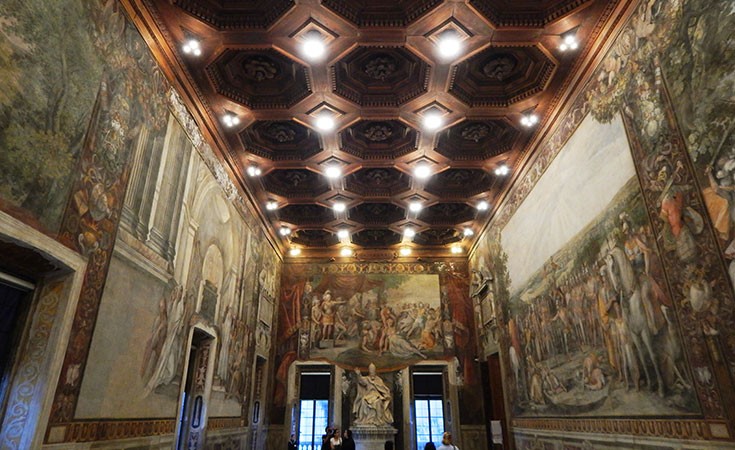
In Italian Musei Capitolini is actually a single museum that hosts an incredibly large collection of antique statues, works of art, collection of ancient jewelry and coins, state archives engraved in bronze plates, elements of civilization from which many other civilizations take roots, and finally beautiful and breathtaking rooms richly decorated.
These museums are located on the Capitol hilltop, in historically significant buildings Palazzo dei Conservatori, Palazzo Clementino- Caffarelli and Palazzo Nuovo which were designed by a famous Renaissance artist and architect, Michelangelo.
The beginnings of the museum can be traced back to the 1471 when Pope Sisto IV gave to the city an important collection of bronze statues, among which there was even the most well-known statue of a female wolf, the symbol of the city. These statues were exhibited in the yard of the Conservatori building as well as on the Capitol Square. The collection was constantly enlarged by donations of Popes, among which the most generous one was Pope Pio V who wanted to throw out all the pagan sculptures and symbols out of Vatican.
According to the wish of Pope Clemente XII, the museum was officially opened to visitors in 1734 while his successor, Pope Benedict XIV, inaugurated the gallery in which art pieces bought from Sacchetti and Pio families were exhibited.
Probably the most well-known art piece of the museum is the statue of Imperator Marco Aurelio on the horseback (Roman imperator that ruled from 161) which was once located on the center of the Capitol square. Today, there is a copy of this statue on the square, while the original was installed in a glass room of the museum after a long restoration.
In the building Conservatori, which was built on top of the walls of once impressive temple of Jupiter, are exhibited the most well-known art pieces of the museum, ancient sculptures mostly of Roman, but also of Greek and Egyptian origin: the head of once colossal sculpture of imperator Constantine (Roman imperator who stopped the prosecution of Christians), the bronze statue of female wolf that according to the legend fed Romulo and Rem (two founders of the city of Rome), frescos depicting battles between the Romans and Hannibal, Medusa of Bernini, statues of bronze geese that saved the city in the conflict with the Gals, the bronze statue of Hercules, as well as numerous statues of rulers and Imperators of the ancient Rome. In one of the corners it is possible to see remains of the walls of once impressive temple of Jupiter, which was a symbol of ancient religion and great Roman Empire.
In the building called Clementino- Caffarelli, you will see collections of coins, medals and jewelry from different periods. It is possible to visit Tabulatium that used to be the state archive where were deposited most important Roman writings, decrees of Senators and peace treaties engraved on bronze plates.
The building Palazzo Nuovo was constructed in the 17th century. Even though it was finished long after the death of Michelangelo, the whole project was associated with him as the mastermind behind it. In the yard of this building there is a 6 meter high statue from the 2nd or 3rd century, called Marforio. It is believed that the name of this statue comes from the God of Mars (God of war) because the statue once stood in the field dedicated to Mars in Rome. Inside the building there are a few well-known sculptures, among which the one of baby Hercules choking the serpent that was sent to kill him in the creed. On the walls you will see small epigraphs, among which there is also “Libretti of Livia” (the wife of the first Roman Imperator Octavian August, who was suspected of killing her husband) and a beautiful marble statue of Venues found in the 10th century in the church of San Vitale. Here you can enjoy the “Room of Imperators” where you will see statues of the imperators from the period when Rome was a republic as well as the “Room of Philosophers” such as Pythagoras, Sophocles, Socrates and Aristocrat.
Ticket prices for Capitoline museums in Rome
Regular ticket price is 15 Euros (€).
Reduced ticket price is 13 Euros (€), (individuals between 6 and 25 years and older than 65)
Free entrance: children younger than 6, disabled individuals and their companions, citizens of Paris, France.
We advise you to check the ticket prices before visiting on the official website of Capitoline Museums in Rome.
Working hours of Capitoline museums in Rome
From Tuesday to Sunday working hours are: 09:00-20:00h (last entrance 19:00h)
Shorter working hours: December 24th, 31st, 09:00-14:00h (last entrance 13:00h)
Closed: January1st, May1st, December 25th.
We advise you to check the working hours of the museum before visiting on the official website of Capitoline Museums in Rome.
Interesting facts